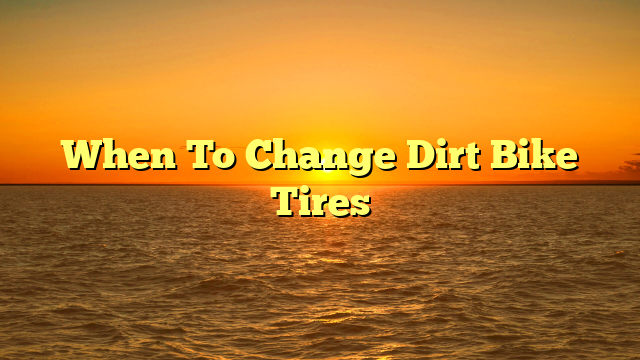Bike tires are a crucial component of any bicycle, as they are responsible for providing traction, stability, and shock absorption while riding.
However, like any other component, bike tires eventually wear out and require replacement.
While there is no exact mileage that bike tires last, several factors can affect their lifespan, including tire type, riding conditions, and maintenance.
In this article, we will explore the question of how many miles do bike tires last.
We will examine the different types of bike tires available and the key factors that can affect their lifespan.
We will also provide practical tips for maintaining your tires to maximize their longevity and performance.
Additionally, we will discuss when it is time to replace your tires and how to choose the right tires for your bike.
Ultimately, this article aims to provide you with the knowledge and tools necessary to keep your bike tires in optimal condition and ensure a safe and enjoyable riding experience.
Table of Contents
- 1 Key Takeaways
- 2 Types of Bike Tires
- 3 Factors Affecting Tire Lifespan
- 4 Riding Conditions and Tire Wear
- 5 Importance of Proper Inflation
- 6 Tire Maintenance Tips
- 7 Signs You Need New Tires
- 8 Choosing the Right Tires for Your Bike
- 9 Maximizing Tire Lifespan for Better Performance
- 10 Frequently Asked Questions
- 10.1 Can a bike tire be repaired or patched, or does it need to be completely replaced when it gets punctured?
- 10.2 How do tubeless bike tires compare in lifespan to traditional tires with inner tubes?
- 10.3 Are thicker or thinner tires better for longevity and durability?
- 10.4 Can different types of bike tires handle different types of terrain, or are they all generally the same?
- 10.5 At what point should you consider replacing your bike tires purely for performance reasons rather than safety concerns?
- 11 Conclusion
Key Takeaways
- The lifespan of bike tires can be affected by tire type, riding conditions, and maintenance.
- Proper storage, maintenance, and regular inspection can help extend the lifespan of bike tires.
- Maintaining optimal tire pressure is crucial for efficient and safe cycling.
- Choosing the appropriate type of bike tire and tread pattern is essential for maximizing performance and ensuring longevity.
Types of Bike Tires
Various types of bike tires exhibit distinct features that affect their durability and performance, making it crucial for riders to choose the appropriate type based on their needs and preferences.
Tube and tubeless tires are the two primary types of bike tires.
Tube tires are the traditional type of bike tires, consisting of a rubber tube inside the tire that holds the air.
In contrast, tubeless tires do not have an inner tube and rely on the sealant to keep the air inside the tire.
Road and off-road are two categories of bike tires that differ in their design and composition.
Road tires are designed for use on smooth, paved surfaces and have a slick tread pattern that reduces rolling resistance and improves speed.
They are usually narrower than off-road tires and have a higher inflation pressure for better performance on paved roads.
Off-road tires, on the other hand, are designed for use on rough, unpaved terrains and have a knobby tread pattern that provides better traction and stability on loose surfaces.
They are wider than road tires and have a lower inflation pressure to absorb shocks and bumps on uneven terrain.
Choosing the appropriate type of bike tire is essential for maximizing your riding experience and ensuring the longevity of your tires.
Factors Affecting Tire Lifespan
Factors such as road surface, tire pressure, and riding style play a significant role in determining the lifespan of a bicycle tire.
One of the key factors that can affect the lifespan of a tire is the material composition.
Different types of tires are made from different materials, and some materials are more durable than others.
For example, some tires are made with Kevlar, a high-strength synthetic fiber that is known for its toughness and durability.
Other tires may be made with softer rubber compounds that provide better grip and traction but may wear out faster.
Another factor that can affect the lifespan of a bicycle tire is environmental factors.
Extreme temperatures, exposure to UV radiation, and moisture can all contribute to the degradation of a tire.
For example, if a tire is left out in the sun for extended periods of time, the rubber may dry out and crack, reducing the tire’s lifespan.
Similarly, if a tire is regularly exposed to moisture or wet conditions, it may be more susceptible to corrosion and damage.
Proper storage and maintenance of bike tires can help extend their lifespan and ensure optimal performance.
Riding Conditions and Tire Wear
Riding on rough or abrasive surfaces, such as gravel or concrete, can cause significant wear and tear on bicycle tires.
The repeated friction and impact of riding on these surfaces can lead to small cuts and abrasions on the tire, which can eventually cause the tire to fail.
Wet weather can also contribute to tire wear, as the moisture on the road can make it more difficult for the tire to maintain traction, which can cause the tire to slip or slide.
To mitigate the effects of rough riding conditions and wet weather, it is important to regularly rotate your bike tires.
This involves moving the front tire to the back and vice versa, which can help to distribute wear more evenly across the tires.
Additionally, properly storing your bike tires can help to extend their lifespan.
Tires should be stored in a cool, dry place, away from direct sunlight or extreme temperatures.
By taking these steps, riders can help to ensure that their bike tires last as long as possible, even in challenging riding conditions and environments.
| Riding Conditions | Effects of Riding Conditions | Mitigation Strategies |
|---|---|---|
| Rough or abrasive surfaces | Cuts and abrasions on the tire | Regular tire rotation |
| Wet weather | Difficulty maintaining traction | Proper tire storage |
| Off-road terrain | Increased risk of punctures and damage | Use puncture-resistant tires |
Importance of Proper Inflation
Maintaining optimal tire pressure is crucial for efficient and safe cycling.
Proper inflation not only affects the longevity of bike tires but also plays a significant role in the overall performance and handling of the bicycle.
Underinflated tires can lead to increased rolling resistance, making it harder to pedal and decreasing speed.
It can also cause tire damage, especially when the tire is pinched between the rim and an obstacle, such as a pothole or curb.
The resulting pinch-flat can lead to a puncture, requiring a replacement tire or inner tube.
Overinflated tires, on the other hand, can reduce grip and handling, making it more challenging to control the bike in corners or slippery conditions.
To ensure proper inflation, it is essential to use a reliable pressure gauge and check the tire pressure regularly.
The recommended tire pressure can usually be found on the sidewall of the tire or in the bike manual.
It may also vary depending on the rider’s weight, riding conditions, and tire size.
Troubleshooting tips for tire pressure problems include checking for leaks or punctures, using a high-quality pump, and avoiding extreme temperature changes.
In summary, maintaining proper tire inflation is critical for both the longevity of the tire and the safety and performance of the bicycle.
Tire Maintenance Tips
One important aspect of tire maintenance is regularly inspecting the tread for signs of wear and tear.
The tread is the part of the tire that comes into contact with the road, and it’s critical for grip and stability while cycling.
Over time, the tread wears down, and the tire becomes less effective at gripping the road.
To avoid this, cyclists should regularly check their tires for signs of wear and tear, such as uneven wear patterns or bald spots.
If the tread is worn down, it’s time to replace the tire.
Another essential aspect of tire maintenance is cleaning and proper storage.
Dirty tires can become damaged over time, which can lead to punctures, leaks, and other issues.
To keep tires in good condition, they should be cleaned regularly, using a soft-bristled brush and mild soap.
Avoid using harsh chemicals or scrubbing too hard, as this can damage the tire’s surface.
After cleaning, tires should be stored in a cool, dry place, away from direct sunlight and extreme temperatures.
This will help prevent cracking and other forms of damage, ensuring that the tires last as long as possible.
Signs You Need New Tires
Indications that it is time to replace your bicycle tires include worn-out or uneven treads, cracks, and bulges on the sidewall of the tire.
Worn tread is a common sign that it is time to replace your tires.
Tires with worn tread have reduced grip, which can cause accidents and make it difficult to control your bike.
Uneven tread wear can also be a sign of a problem with your bike’s alignment or the way you ride.
Bulges on the sidewall of the tire are another sign that your bike tires need to be replaced.
This can be caused by a number of factors, including underinflation, overloading, or damage to the tire.
In some cases, bulges can lead to tire blowouts, which can be dangerous.
However, before replacing your tires, it is important to consider other factors that can affect tire performance, such as tire pressure and punctures.
Here are four things to keep in mind when assessing the condition of your bike tires:
- Check your tire pressure regularly and make sure it is within the recommended range.
- Look for signs of punctures or damage to the tire that may require repair or replacement.
- Consider the type of riding you do and choose tires that are appropriate for your needs.
- When replacing your tires, make sure to choose high-quality tires that are designed for your bike’s size and type.
Choosing the Right Tires for Your Bike
Selecting the appropriate tires for your bicycle is crucial for optimal performance, safety, and comfort during your rides.
One of the first decisions you need to make is whether to go for tube or tubeless tires.
Tube tires are the traditional option, with an inner tube filled with air that sits inside the tire casing.
On the other hand, tubeless tires do not require an inner tube and instead have a sealed system that relies on sealant to prevent punctures and maintain pressure.
Tubeless tires have the advantage of being more resistant to punctures and offering a smoother ride due to their ability to run at lower pressures.
However, they are more expensive and require a specific rim to be installed.
Another important aspect to consider when selecting your bike tires is the tread pattern.
Tread patterns play a significant role in how your bike handles different terrain types.
A knobby tread pattern is ideal for off-road riding as it provides better traction on loose surfaces, while a slick or semi-slick tread pattern is more suitable for road riding as it offers low rolling resistance and increased speed.
Additionally, some tires have a tread pattern designed for specific weather conditions, such as rain or snow.
Ultimately, the choice of tread pattern will depend on the type of riding you plan to do, so make sure to consider your needs and preferences before making a decision.
| Tube Tires | Tubeless Tires | |
|---|---|---|
| Puncture Resistance | Less resistant | More resistant |
| Cost | Cheaper | More expensive |
| Maintenance | Requires regular checks for air pressure and punctures | Requires occasional sealant checks and replacement |
| Rim Compatibility | Compatible with most rims | Requires a specific rim to be installed |
Table: Comparison of Tube Tires and Tubeless Tires.
Maximizing Tire Lifespan for Better Performance
To optimize the performance and longevity of your bicycle tires, it is important to follow proper maintenance and care guidelines.
One of the key factors in maximizing tire lifespan is regular tire rotation.
This involves moving the front tire to the back and vice versa, as well as swapping the left and right sides.
Tire rotation helps ensure even wear across the tread pattern, which can extend the life of the tire and improve overall performance.
In addition to tire rotation, paying attention to tread patterns is also important for maximizing tire lifespan.
Different tread patterns are designed for different types of riding, and choosing the right pattern for your needs can help prevent premature wear and tear.
For example, slick or semi-slick tread patterns are ideal for road riding, while knobby or aggressive tread patterns are better suited for off-road or mountain biking.
By selecting the appropriate tread pattern and regularly rotating your tires, you can help extend the life of your bike tires and enjoy better performance for longer.
Proper maintenance and care, including regular tire rotation and selecting the appropriate tread pattern, can help maximize tire lifespan and improve overall performance.
Frequently Asked Questions
Can a bike tire be repaired or patched, or does it need to be completely replaced when it gets punctured?
When a bike tire gets punctured, it can often be repaired or patched by a professional.
However, if the damage is severe or the tire is worn from lack of maintenance, it may need to be replaced entirely.
Proper tire maintenance can extend the life of a bike tire.
How do tubeless bike tires compare in lifespan to traditional tires with inner tubes?
A comparison between tubeless and traditional tires with inner tubes reveals that tubeless tires have better puncture resistance and reduced wear and tear.
Moreover, tubeless tires have lower rolling resistance than traditional tires, resulting in improved performance.
Are thicker or thinner tires better for longevity and durability?
Thicker tires offer greater stability and durability, but thinner tires provide better grip.
Tire tread patterns play a crucial role in tire performance and durability.
The choice between thick and thin tires ultimately depends on the rider’s specific needs and preferences.
Can different types of bike tires handle different types of terrain, or are they all generally the same?
Different types of bike tires are designed for specific terrains, such as road vs.
mountain biking.
Tread patterns and tire material options also affect performance.
Maintenance tips include maintaining proper tire pressure, choosing the right tire size, and using puncture-prevention strategies.
Tubeless options and replacing worn-out tires are important considerations, as well as comparing different tire brands.
At what point should you consider replacing your bike tires purely for performance reasons rather than safety concerns?
Optimal tire replacement timing for performance depends on various factors affecting tire longevity, including tire type, terrain, weather conditions, and frequency of use.
It is recommended to replace tires when the tread wears down to a certain level, rather than waiting for safety concerns.
Conclusion
Bike tires are an essential component of a bicycle and are designed to provide traction and stability while riding.
The lifespan of a bike tire varies depending on several factors such as the type of tire, riding conditions, and proper maintenance.
It is important to understand these factors to maximize the lifespan of your bike tires and ensure better performance.
There are several types of bike tires, including road, mountain, hybrid, and touring tires.
Each type of tire is designed for a specific purpose and has a different level of durability.
The lifespan of a tire also depends on the type of rubber used in the tire’s construction.
The softer the rubber, the faster the tire wears out.
Additionally, factors such as the weight of the rider, frequency of use, and riding style can all affect the tire’s lifespan.
Proper inflation is essential to maximize the lifespan of a bike tire.
Under-inflated tires can cause excessive wear on the sidewalls, while over-inflated tires can cause the tire to become brittle.
Regular maintenance, such as checking the tire pressure, inspecting the tread, and cleaning the tires, can also help prolong the lifespan of your bike tires.
Signs that indicate the need for new tires include worn tread, sidewall damage, and frequent punctures.
Choosing the right tires for your bike can also affect their lifespan.
It is important to consider the type of riding you will be doing, the terrain, and the weather conditions.
Additionally, investing in high-quality tires can also increase their durability and performance.
By understanding the factors that affect tire lifespan and proper maintenance techniques, you can ensure that your bike tires last longer and provide better performance.







